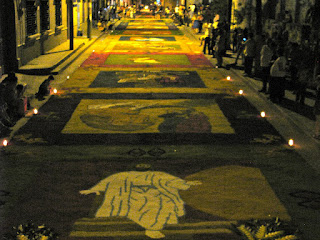
We've made it through our first Semana Santa - Easter Week - in Copan Ruinas.
It's a fascinating phenomenon.
For starters, it's the year's big holiday, and much of the country is on the move. The public sector, and some businesses, shut down for the week; most operations just knock off early on Wednesday and don't re-open until Monday.
The tradition is that people travel for a brief break - to the beaches, or back home if they have moved away, or just somewhere different. The main bus terminal in San Pedro Sula handled some 1.3 million people in the week, mostly in the last five days. The roads are jammed, buses packed, prices rise and people crowd into the tourist spots. (That's not just true in Honduras; we avoided Semana Santa travel in Mexico after seeing pictures of beaches we knew as uncrowded staked out with tents from the high-tide line on back.)
And, of course, there is Easter. On Palm Sunday - the week before Easter, for those out of touch - there was a procession to the Catholic church on the square, with everyone carrying big palm branches. (Much more dramatic than the little folded palm crosses I remember from my Anglican youth.)
On Thursday, the night before Good Friday, they decorated two blocks with alfombras - literally carpets, but in this case elaborate scenes created on the street with coloured sawdust. Volunteers started work that night, laying down a base and using stencils to add colours from big bags of dyed sawdust. By about 2 a.m. they had created one block of scenes from the life of Jesus, and another of Mayan symbols. (The alfombras in the big cities are hugely elaborate.)
On Good Friday, there were morning and evening processions. We followed the morning group, which sets out from the church, people in robes carrying draped tables with large sculptures of Christ and the disciples, several hundred others following along. At each of the stations of the cross - 14 here - the procession stops and there is a Bible reading and brief sermon. The stations, on the cobbled streets, were decorated with draperies and a carpet of the long green pine needles that grow on the trees in the hills.
The sun beat down and it was roasting, in the low 30s, and the route led up steep, cobbled hills. It was impressive, especially when a group of women - mothers, obviously - came down from the Barrio Buena Vista carrying a platform with a haunted looking Mary, meeting with the main procession at Station 4, where Jesus meets his mother on the way to Calvary.
The spoken messages at each stop were interesting. The theme seemed to be how messed up Honduras has become - crime, corruption, drugs, alcohol - and that it was time to do something about it. (Though what was less than clear.)
When I watched celebrations from other cities on TV, the Catholic priests were talking about the same things. It appeared to be an orchestrated message, though less than half of Hondurans now identify as Catholic; evangelical churches have made great strides.
The evening procession was smaller, and the last few hundred yards were over the alfombras, scuffling them into obscurity. It was a mix of highly traditional rituals and low-budget technology. For music, a kid was carrying a $50 battery-power boom box, a guy walked in front of him holding a microphone, and a third person - who must have been deaf by the end of the day - walked in front with a giant white megaphone on his shoulder.
There was a fair amount of partying going on during Semana Santa as well. One of the messages in the procession was that people should be spending more time reflecting on Easter's meaning, and less on plans to hit the beach.
The president - Porfiro Lobo - made the same point in a statement as the week began. He urged all Hondurans to use Semana Santa as a time to reflect, and think about what they should and should not do. He suggested strongly he was spending the week at the family ranch doing just that.
But La Prensa found his photo on David Copperfield�s website, posing with the magician after catching his show in Las Vegas. It's a sore point, as many politicians apparently head to Miami and other U.S. destinations for the week, while most people pile into a bus and head to a crowded beach.
By Sunday morning, the sawdust was swept up. By the afternoon, things were back to normal.
But there was a cost to all that rushing around. The accidental death toll from the holiday included 29 people killed on the roads and 18 drownings. About 30 people drown in B.C. in a year. Honduras has twice the population, but 18 in a week shows a certain casualness about life and death that seems a problem down here.





